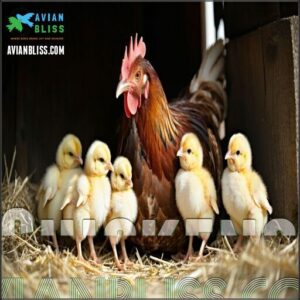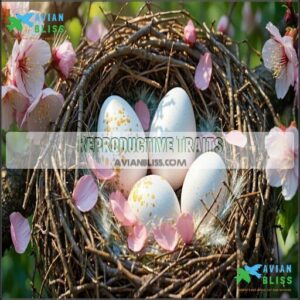This site is supported by our readers. We may earn a commission, at no cost to you, if you purchase through links.
 A female bird is commonly called a hen, but it gets more interesting depending on the species.
A female bird is commonly called a hen, but it gets more interesting depending on the species.
For example, a female peafowl is a peahen, while female ducks are simply called ducks (no fancy title there). Chickens stick with the classic "hen," and swans use "pen" for their ladies.
You’ll find that not all birds have gender-specific names, but when they do, it often reflects their role in reproduction or behavior. Fun fact: in birds of prey, females are typically larger than males—talk about girl power in the animal kingdom!
Curious about other species? There’s plenty more to uncover.
Table Of Contents
- Key Takeaways
- Female Bird Terminology
- What is Female Bird Called
- Female Bird Classification
- Unique Female Bird Names
- Female Bird Identification
- Frequently Asked Questions (FAQs)
- What is a female bird called?
- What do you call a female bird of prey?
- What is a female fowl called?
- What is a female chicken called?
- Why are female birds called hens?
- Is a female bird a Ree?
- What is the female version of a bird?
- What are male and female terms for birds?
- What is a bird woman called?
- Is a female bird called a hen?
- Conclusion
Key Takeaways
- Female birds are commonly called hens, but species-specific names like peahen (peafowl) or pen (swans) add variety.
- Female birds often have muted plumage for camouflage, contrasting with males’ brighter colors.
- Birds of prey show reversed dimorphism, with females larger and more dominant than males.
- Gender identification in birds often relies on behavior , physical traits, or DNA testing for accuracy.
Female Bird Terminology
You’ll discover that female birds have specific names beyond just "female," with terms varying widely across different species.
While "hen" is commonly used for many female birds, you’ll also encounter fascinating species-specific names like "peahen" for peacocks and "pen" for swans.
Common Names for Female Birds
In the context of avian nomenclature, "hen" stands out as the most widely used term for female birds across many species.
You’ll encounter this term frequently in both casual and scientific contexts.
Here are four common female bird names that highlight our fascinating feathered friends:
- Hen – The universal term used for most female birds
- Duck – Specifically for female waterfowl (males are drakes)
- Peahen – The less flamboyant counterpart to peacocks
- Falcon – Female raptors often share the species name
The provided list aims to educate readers about the diverse terminology used for female birds, making it easier to understand and appreciate these creatures.
Species-Specific Terms
While "hen" is a common term for adult female birds, you’ll find fascinating species-specific variations in avian nomenclature.
Female ducks are called "hens" while their male counterparts are "drakes." A female goose is simply a "goose," not a "hen goose."
In swans, females are referred to as "pens." For ostriches and emus, the term "ewe" is sometimes applied, borrowing terminology from mammal classification.
Female pheasants, however, exhibit mottled brown plumage for camouflage.
Cultural and Linguistic Variations
Beyond the specific terms for female birds, fascinating cultural variations exist worldwide.
Did you know that female birds often use regional song dialects, similar to human linguistic differences?
In some cultures, indigenous terms for female birds carry special significance in local traditions.
You’ll find that avian female terminology varies dramatically across regions – what’s called a hen in English might’ve an entirely different name elsewhere, reflecting unique naming traditions and cultural perspectives, including regional song dialects and cultural variations.
What is Female Bird Called
In the aviary world, the most common female bird name is "hen," though this terminology varies widely across species.
You’ll hear it most frequently when referring to chickens, but it applies to many female birds regardless of species. While "hen" dominates avian female terminology, some birds have unique gender designations—female ducks are called "ducks" (males are "drakes"), female peacocks are "peahens," and female swans are "pens."
The etymology of these terms often dates back centuries, with naming history deeply rooted in regional bird names and cultural traditions.
When discussing immature females, terms like "pullet" describe young female chickens specifically.
Not every female bird gets a special designation—for many species, you’ll simply add "female" before the bird name. Female cowbirds, for example, exhibit a unique behavior of laying eggs in nests of other bird species. Remember, what’s called a hen in one region might’ve another name elsewhere!
Female Bird Classification
When you classify female birds, it’s all about understanding their roles, traits, and behaviors across species.
From birds of prey to waterfowl, each group has unique features that make them fascinating to study.
Birds of Prey
Female birds of prey, often called “hen raptors” or “falconesses,” stand out for their reversed dimorphism—females are larger than males.
Female raptors showcase reversed dimorphism, with larger females dominating males, highlighting their strength and adaptability in the wild.
This size difference boosts hunting behavior, like catching bigger prey.
Eagles and falcons exhibit remarkable female aggression, especially when defending nests.
Unlike some birds, raptors share nesting habits with males, but females dominate during reproductive periods, showcasing their incredible adaptability and reversed dimorphism.
Waterfowl
In the context of waterfowl, ducks and geese have fascinating distinctions.
A female duck, often called a hen, typically has duller plumage, blending perfectly into her environment.
Female geese, or simply goose, tend to display unique nesting behaviors, while swan nesting is a symbol of dedication.
Fun fact: waterfowl migration patterns often reveal the stark divide in size between males and females!
Landfowl
Landfowl, like chickens and pheasants, feature classic hen terminology.
Hens, the female birds, often show landfowl dimorphism, with subdued colors for camouflage.
Nesting behavior displays their natural instinct for brood care and egg-laying.
Domestic fowl, such as poultry, rely on fastidious care, highlighting their role in sustenance.
Ever notice a chicken bossing the flock? That’s hen hierarchy in action, demonstrating a natural behavior where one hen takes charge, and this is a key aspect of their social structure.
Other Bird Species
Across exotic hens like parrots or migratory hens such as sandpipers, female bird species vary widely.
Some rare females stand out among tropical birds or endangered birds. Here’s a quick look:
- Kiwi hens are unique, laying enormous eggs for their size.
- Female albatrosses share lifelong bonds with mates.
- Penguins’ female roles include tender chick care.
Unique Female Bird Names
In the case of female birds, some species have unique names that reflect their distinct roles and characteristics.
From "hens" in chickens to "pens" in swans, these terms provide insight into the fascinating world of bird behavior and biology.
Chickens
In the domain of poultry, a mature female bird is called a hen, while younger ones are pullets.
Hen terminology is essential for understanding egg production and Pullet development.
Broody hens, often from specific chicken breeds, show maternal instincts by sitting on eggs.
Chickens, as domestic fowl, highlight the versatile roles of female birds in farming and daily life.
Swans
Ever wondered what a female swan is called? It’s a "swan pen", a name as graceful as her elegant appearance.
A female swan, known as a "pen," embodies elegance and devotion, fiercely protecting her cygnets with unmatched grace.
Pens are devoted parents, fiercely protective of their cygnets. Their mating rituals, like synchronized swimming, are mesmerizing.
Understanding bird gender identification aids swan conservation efforts, ensuring these majestic creatures thrive for generations. Who knew naming could be this fascinating?
Peafowls
Peafowls are famous for their striking beauty. While male peacocks dazzle with their vibrant feathers, the female peafowl, or peahen, boasts subtler plumage for camouflage.
Peahen behavior often centers on nesting and protecting chicks. Their muted coloring helps them blend in.
Here’s what makes peahens fascinating:
- Earthy-toned plumage blends into habitats.
- Prefers roots, seeds, insects in diet.
- Lives near forests or grasslands.
- Devoted mothers.
- Key to peafowl conservation.
Ducks
In the duck world, a female bird is often called a hen.
With her subtle Duck Plumage, she blends into her surroundings, especially during Duck Nesting season.
Duck hens play essential roles in Duck Conservation by caring for their young.
Their Duck Diets, full of plants and insects, support their health.
These waterfowl are multitasking pros, balancing survival and future generations, which is crucial for their Duck Diets.
Female Bird Identification
Spotting a female bird takes careful observation, as they’re often less colorful and smaller than their male counterparts.
You’ll need to pay attention to subtle details like plumage, behavior, and nesting habits to get it right, which requires careful observation.
Physical Characteristics
Spotting a female bird? Let’s talk physical characteristics. Their plumage coloration is typically muted for camouflage, with browns and olive tones.
Size dimorphism often makes females smaller, except in raptors where larger hens dominate. Feather patterns can be less flashy but purposeful.
A useful bird identification resource can further aid in distinguishing subtle differences.
Look for:
- Duller feather tones.
- Subtle body shape differences.
- Shorter plumes.
- Practical patterns aiding survival.
Behavioral Differences
When observing behavioral differences, female birds often exhibit pronounced nesting habits and territorial aggression, especially during breeding seasons.
Hens may take on more parental roles, like incubating eggs or feeding young. Their vocalizations are generally softer, contrasting with the mating rituals of males.
Aggression levels can peak to protect nests, showcasing unique female bird characteristics essential for understanding bird gender behaviors.
Some species also use flocking for foraging and predator avoidance.
Reproductive Traits
Reproductive traits in female birds are fascinating! A hen’s biology is perfectly tuned for egg formation and raising young.
Here’s what to know:
- Clutch Size: Females lay a specific number of eggs per season.
- Hormonal Influence: Hormones trigger nesting and incubation behavior.
- Nest Building: Females craft nests with care.
- Egg Formation: Eggs develop inside the female bird.
- Incubation Behavior: Females keep eggs warm until hatching.
Some may even purchase supplies for eggs.
Gender Determination Methods
After exploring reproductive traits, let’s talk gender determination. Identifying female birds often requires tools like DNA sequencing or Chromosome analysis.
Hormone testing and laparoscopy methods help too, though behavioral cues can offer hints. A good bird sexing guide explains subtle traits, like nesting habits.
DNA testing remains the gold standard, especially for species where males and females look identical. For accurate results, consider using a reliable bird DNA test.
Frequently Asked Questions (FAQs)
What is a female bird called?
A female bird is often called a hen, though the term varies by species.
For instance, female ducks are simply "ducks," while peafowls are "peahens."
In many cases, species name works universally.
What do you call a female bird of prey?
You’d call a female bird of prey the same as the species name—like a hawk or eagle.
However, in scientific contexts, they’re sometimes just referred to as “females,” with size often distinguishing them from males.
What is a female fowl called?
Did you know hens can lay over 300 eggs a year?
That’s right—female fowl, like chickens, are commonly called hens.
This term highlights their role in egg-laying, though it’s not species-specific.
What is a female chicken called?
A female chicken is called a hen once she’s mature and laying eggs.
Before that, she’s a pullet, which is basically a teenage chicken figuring life out—minus the bad haircuts and curfews.
Why are female birds called hens?
Female birds are often called hens because the term historically ties to egg-laying and motherhood, especially in domestic species like chickens.
It’s a simple label that highlights their reproductive role across bird species, and is a universal term.
Is a female bird a Ree?
A female bird isn’t called a “Ree.”
That term doesn’t apply in ornithology.
Instead, female birds are often called “hens,” but names vary by species, like “goose” for geese or peahen for peacocks.
What is the female version of a bird?
You’d typically call a female bird a “hen,” though it depends on the species.
Ducks are “ducks,” swans are “pens,” and peahens exist too.
It’s like birds have their own quirky naming system!
What are male and female terms for birds?
Did you know some female raptors are up to 30% larger than males.
Male birds are often called cocks, while females are hens, though terms like peahen or goose apply depending on the species.
What is a bird woman called?
A "bird woman" doesn’t refer to female birds but might describe a passionate bird enthusiast or ornithologist.
If you’re asking about female birds, they’re often called hens, though names vary by species.
Is a female bird called a hen?
In the context of birds, the term "hen" often fits the bill for adult females, especially in domestic species like chickens.
However, not all female birds are called hens—names vary by species!
Conclusion
Just like a puzzle with many pieces, the answer to "what is a female bird called" depends on the species.
From hens and pens to peahens and beyond, these names often reflect fascinating roles in nature.
Whether it’s the larger size of female birds of prey or the graceful elegance of a swan, each species tells its own story.
Next time you spot a bird, take a closer look—you might just uncover another feathered mystery, and learn something new about the natural world with fascinating roles.














